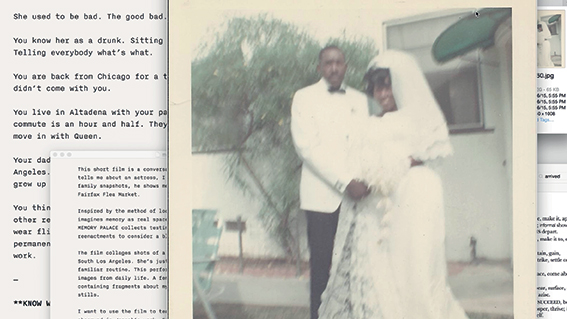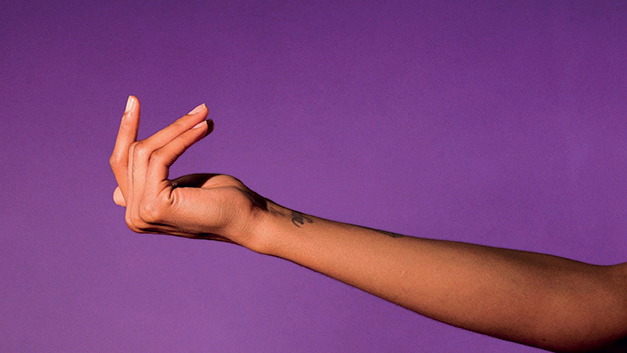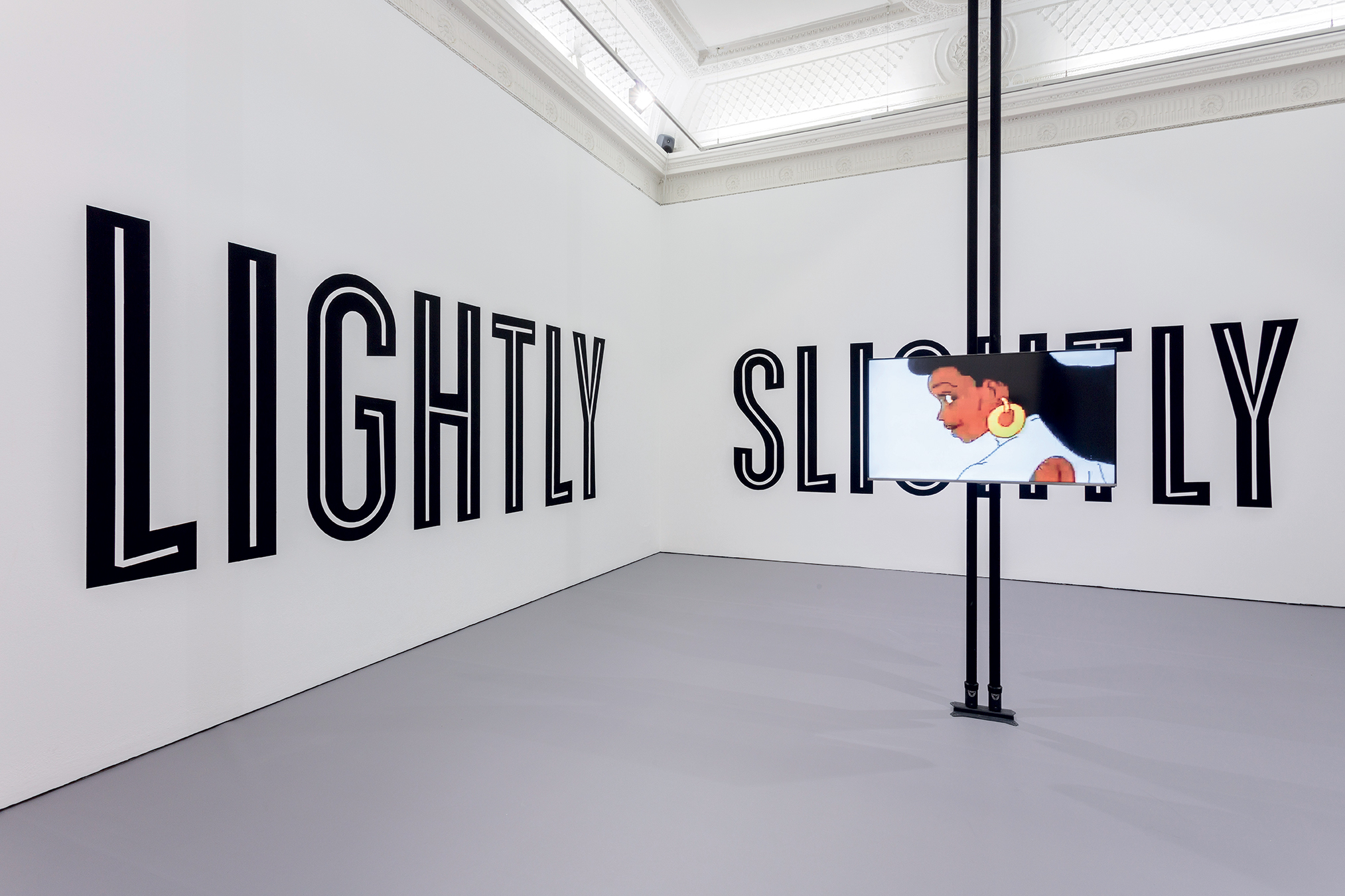Purple Magazine
— The Los Angeles Issue #30 F/W 2018
martine syms
los angeles
art
martine syms
interview by MAURIZIO CATTELAN AND MARTA PAPINI
portrait by TAYLOR RAINBOLT
All artworks copyright of the artist
 MARTINE SYMS AND KAHLIL JOSEPH STILL FROM MEMORY PALACE, 2015
MARTINE SYMS AND KAHLIL JOSEPH STILL FROM MEMORY PALACE, 2015
Los Angeles artist Martine Syms explores all avenues of contemporary African-American identity politics, and ostracism in popular culture. She plays with a variety of media, including video, performance, and writing, to create visually stimulating installations. She’s also the founder of Dominica Publishing, an artists’ imprint dedicated to the topic of blackness in art and culture.
MAURIZIO CATTELAN AND MARTA PAPINI — How long have you been living in Los Angeles?
MARTINE SYMS — I was born and raised here.
MAURIZIO CATTELAN AND MARTA PAPINI — Where do you feel LA is placed today: east of China or west of New York?
MARTINE SYMS — My experience of Los Angeles has always been east of China, but I grew up in the San Gabriel Valley immersed in Chinese culture. Los Angeles is massive, decentralized, and horizontal. I don’t think the city has much in common with New York. It’s organized differently. You have to accept Los Angeles on its own terms. One time at a fancy art dinner in New York (at which I subsequently got very drunk and vomited on our table), a Swiss collector said to me, “Los Angeles isn’t even a city by European standards!” Exactly, and we fucking like it that way.
MAURIZIO CATTELAN AND MARTA PAPINI — Is there a red zone in the city that you won’t visit if not forced? If so, why?
MARTINE SYMS — There has to be a very good reason — money, incredible food, sex, death, good drugs, free clothes, etc. — for me to go to Beverly Hills, Venice, Santa Monica, or Highland Park. I used to work in Beverly Hills, and it’s so tacky and boring. I wish it were more glamorous. Rodeo Drive is probably one of the boulevards of broken dreams. Venice I’ll go to after 9 PM for those aforementioned reasons. Santa Monica is a tough sell because I don’t want to be in traffic, or surrounded by white people. I used to go to shows in Highland Park, and for a while my friends threw this great party there, but lately it reminds me of Ann Arbor, Michigan, or Austin, Texas. Both of which are perfectly fine places, but they aren’t LA.
MAURIZIO CATTELAN AND MARTA PAPINI — Are wild pursuits the latest version of public performance?
MARTINE SYMS — I hate to call it a performance, though. My wild pursuits are for me and about me. It’s all about my damage and desire. The latest version of public performance is the extended psychological adolescence that
is so pervasive these days. Everyone wants to fit in, get approval, and feel good all the time.
MAURIZIO CATTELAN AND MARTA PAPINI — Is art about entertainment?
MARTINE SYMS — Good question. I like to surprise and delight, but I also like to punish. So … no? Wait, definitely NO. Art isn’t about anything.
 MARTINE SYMS
MARTINE SYMS
MAURIZIO CATTELAN AND MARTA PAPINI — Are there any taboos left?
MARTINE SYMS — Sure, tons. This is a question that belies a lot of privilege. I don’t feel like explaining why.
MAURIZIO CATTELAN AND MARTA PAPINI — What do you think is missing in art?
MARTINE SYMS — Non-white, non-Western, economically and socially diverse work, narratives, histories, experiences, leadership, staff, artists, and so on. Also, fewer men talking all the time about nothing. Shut the fuck up.
MAURIZIO CATTELAN AND MARTA PAPINI — What’s the most fundamental aspect in a work of art, from your point of view?
MARTINE SYMS — There are three essentials: 1/ a clear voice; 2/ an encounter; 3/ stakes.
MAURIZIO CATTELAN AND MARTA PAPINI — Do you think art could be a way to overcome fear — to face the unknown, somehow?
MARTINE SYMS — Therapy is a better way to share, understand, accept, and work through fears. Being an artist requires a relationship with the unknown. In addition to therapy, I recommend the book Art & Fear [by David Bayles and Ted Orland]. It has a great cover, and I discovered it on the desk of Barbara Kasten while I was her studio manager. It took me a year to finally crack it open. I was afraid. I love that book. My process is quite tortuous because I hate not knowing. I am getting better with the divine feminine. Baby steps.
MAURIZIO CATTELAN AND MARTA PAPINI — Are we in a condition of constant fear or constant indifference?
MARTINE SYMS — There are no constant conditions. Fear is normal. Some things I fear: knowing, having, showing feelings; lions and tigers; failure and success; being broke; being alone; closeness; getting fucked over; giving/receiving; saying no/saying yes; losing money; losing face; losing freedom; losing friends; losing family; losing respect; losing status; losing my job; losing out. Losing is a big one for me, clearly. What else? I recommend the book When Love Meets Fear: How to Become Defense-less and Resource-full, by David Richo. I listen to all of his tapes in the car. So, if you ever pull up next to me at an intersection, that’s why I’m crying. Indifference is also fear: fear of putting yourself out there. I get very impatient with people who are indifferent. I’m trying to be more compassionate.
 MARTINE SYMS, STILL FROM NOTES ON GESTURE, 2015
MARTINE SYMS, STILL FROM NOTES ON GESTURE, 2015
MAURIZIO CATTELAN AND MARTA PAPINI — Do you think that art can play the role of a forerunner?
MARTINE SYMS — I want it to. I believe it can. Right now, everything is very conservative, especially the art world. We lost the fucking culture war. You have to be able to make art about anything. Of course, you remain accountable to it, but it should be the place where everything is on the table. I feel right now that people hate the representation of atrocity more than they hate the actual atrocities. I have experienced well-meaning white people decrying a work of art for being “racist.” Meanwhile, they don’t say shit while they observe actual fucking racism on a goddamn daily basis. It drives me insane.
MAURIZIO CATTELAN AND MARTA PAPINI — If not in the museum or galleries, where is the avant-garde today?
MARTINE SYMS — Do people still say “avant-garde”? Is that still a thing? Whatever it is, it is 100% not in the museum or gallery and never has been. I’ve been thinking a lot about the underground lately. That’s my preferred term. I think the economic climate is killing it softly, but that drum machine will never die, man. I’m trying to think how I find the “underground” when I travel. My first stop is usually the swap meet.
MAURIZIO CATTELAN AND MARTA PAPINI — What is the worst compliment you’ve gotten about your work?
MARTINE SYMS — It irks me when people say my work is “powerful.” It feels like a code word.
 MARTINE SYMS, FACT & TROUBLE, 2016 EXHIBITION, PHOTO MARK BLOWER
MARTINE SYMS, FACT & TROUBLE, 2016 EXHIBITION, PHOTO MARK BLOWER
MAURIZIO CATTELAN AND MARTA PAPINI — And the best critique?
MARTINE SYMS — A friend said my show looked like it was done by six different people.
MAURIZIO CATTELAN AND MARTA PAPINI — Are you still able to waste your time?
MARTINE SYMS — Yes. I will never stop wasting my time. I’m very protective of my time: burning incense, reading, napping, opening the fridge and cabinets 12 million times, bullshitting with my friends, lurking and fucking around on the Internet, listening to tunes, watching TV, strolling the block, smurfing the neighborhood, going to the movies, staring out my window, driving aimlessly, and most importantly, singing in the tub.
MAURIZIO CATTELAN AND MARTA PAPINI — A forecast: will your work remain in history?
MARTINE SYMS — Yes. I’m in it for the long haul.
 MARTINE SYMS THE QUEEN’S ENGLISH, 2014 EXHIBITION AND READING ROOM INSTALLATION VIEW
MARTINE SYMS THE QUEEN’S ENGLISH, 2014 EXHIBITION AND READING ROOM INSTALLATION VIEW
MAURIZIO CATTELAN AND MARTA PAPINI — Did you already make your masterpiece?
MARTINE SYMS — Do you only get one masterpiece? I’ve been listening to The Miseducation of Lauryn Hill a lot lately. She created a fucking masterpiece, and it still wasn’t enough. I’m focused on creating the conditions that will let me keep making work for as long as I can. I’ll only be able to parse it out in retrospect. I have made some things that I like. That’s enough for me.
MAURIZIO CATTELAN AND MARTA PAPINI — Do you ever consider the audience’s reactions?
MARTINE SYMS — I always think about audience reaction. I can control it. I can engender a response. I can move them — physically and emotionally. Why wouldn’t I think about what I’d like them to do? It seems like a key characteristic of the work, similar to how you’d approach the frame or the wall. I don’t care whether or not they’re going to approve.
MAURIZIO CATTELAN AND MARTA PAPINI — Can you imagine a world without art?
MARTINE SYMS — I can. I start to imagine a future-primitive dystopian narrative with a mind-controlling, evil-corp president.
MAURIZIO CATTELAN AND MARTA PAPINI — How do you think your career will end?
MARTINE SYMS — The word “career” is throwing me off. I don’t know if being an artist is my occupation, exactly. I did start writing it on my tax forms, which felt significant. I’d stated “graphic designer” as my occupation for the past decade. If money were no issue, I could see myself becoming a hermit. That would probably end my career.
MAURIZIO CATTELAN AND MARTA PAPINI — And how would you like your life to end?
MARTINE SYMS — I’d like my life to end in a blaze of glory. Police chase. Thelma & Louise style. Looking into the eyes of my partner in crime and squeezing her hand as we leap into our next life.
MAURIZIO CATTELAN AND MARTA PAPINI — Tell us an LA story that occurred to you.
MARTINE SYMS — You mean, like, noir? I live in an Art Deco apartment building across the street from a country club. It used to be a hotel. There are five identical floors, with 18 units each. The apartments are studios or one-bedrooms, and have a single-occupancy restriction. Over the past few months, I’ve become very invested in one of my neighbors — we’ll call him Charles. Charles lives kitty-corner from me, and we run into each other every day at the same time. He takes the elevator with his dog, Polly. I take the stairs. I stopped seeing Charles in the corridor, but I could still hear Polly’s heavy breathing when I passed his door. Near Valentine’s Day, there was a small heart placed at his doorstep. The following week, a man wearing a fedora emerged from Charles’s apartment with Polly in tow. Charles would NEVER wear a fedora. I ran over to him and spat, “Where’s Charles?” The man smiled slowly. “Charles is taking a little vacation,” he said. He tugged on Polly’s leash, and they walked away.
END

























































































































































































































